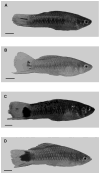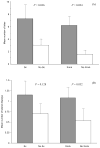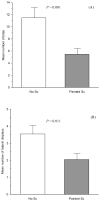A cancer-causing gene is positively correlated with male aggression in Xiphophorus cortezi
- PMID: 20021547
- PMCID: PMC2901164
- DOI: 10.1111/j.1420-9101.2009.01914.x
A cancer-causing gene is positively correlated with male aggression in Xiphophorus cortezi
Abstract
The persistence of seemingly maladaptive genes in organisms challenges evolutionary biological thought. In Xiphophorus fishes, certain melanin patterns form malignant melanomas because of a cancer-causing gene (Xiphophorus melanoma receptor kinase; Xmrk), which arose several millions years ago from unequal meiotic recombination. Xiphophorus melanomas are male biased and induced by androgens however male behaviour and Xmrk genotype has not been investigated. This study found that male X. cortezi with the spotted caudal (Sc) pattern, from which melanomas originate, displayed increased aggression in mirror image trials. Furthermore, Xmrk males (regardless of Sc phenotype) bit and performed more agonistic displays than Xmrk deficient males. Male aggressive response decreased when males viewed their Sc image as compared with their non-Sc image. Collectively, these results indicate that Xmrk males experience a competitive advantage over wild-type males and that intrasexual selection could be an important component in the evolutionary maintenance of this oncogene within Xiphophorus.
Figures



Similar articles
-
Selection for a dominant oncogene and large male size as a risk factor for melanoma in the Xiphophorus animal model.Mol Ecol. 2010 Aug;19(15):3114-23. doi: 10.1111/j.1365-294X.2010.04738.x. Mol Ecol. 2010. PMID: 20618898 Free PMC article.
-
The macromelanophore locus and the melanoma oncogene Xmrk are separate genetic entities in the genome of Xiphophorus.Genetics. 1998 Aug;149(4):1909-20. doi: 10.1093/genetics/149.4.1909. Genetics. 1998. PMID: 9691046 Free PMC article.
-
Stable association of a pigmentation allele with an oncogene: nonhybrid melanomas in Xiphophorus variatus.J Hered. 1995 May-Jun;86(3):199-203. doi: 10.1093/oxfordjournals.jhered.a111562. J Hered. 1995. PMID: 7608512
-
Genetic, biochemical and evolutionary facets of Xmrk-induced melanoma formation in the fish Xiphophorus.Comp Biochem Physiol C Toxicol Pharmacol. 2004 Jul;138(3):281-9. doi: 10.1016/j.cca.2004.06.002. Comp Biochem Physiol C Toxicol Pharmacol. 2004. PMID: 15533786 Review.
-
Signal transduction by the oncogenic receptor tyrosine kinase Xmrk in melanoma formation of Xiphophorus.Pigment Cell Res. 1997 Feb-Apr;10(1-2):34-40. doi: 10.1111/j.1600-0749.1997.tb00463.x. Pigment Cell Res. 1997. PMID: 9170160 Review.
Cited by
-
Sex-specific molecular genetic response to UVB exposure in Xiphophorus maculatus skin.Comp Biochem Physiol C Toxicol Pharmacol. 2015 Dec;178:76-85. doi: 10.1016/j.cbpc.2015.07.007. Epub 2015 Aug 6. Comp Biochem Physiol C Toxicol Pharmacol. 2015. PMID: 26256120 Free PMC article.
-
Can Peto's paradox be used as the null hypothesis to identify the role of evolution in natural resistance to cancer? A critical review.BMC Cancer. 2015 Oct 24;15:792. doi: 10.1186/s12885-015-1782-z. BMC Cancer. 2015. PMID: 26499116 Free PMC article. Review.
-
The Mystery of Cancer Resistance: A Revelation Within Nature.J Mol Evol. 2023 Apr;91(2):133-155. doi: 10.1007/s00239-023-10092-6. Epub 2023 Jan 24. J Mol Evol. 2023. PMID: 36693985 Review.
-
Differential regulation of antagonistic pleiotropy in synthetic and natural populations suggests its role in adaptation.G3 (Bethesda). 2015 Feb 23;5(5):699-709. doi: 10.1534/g3.115.017020. G3 (Bethesda). 2015. PMID: 25711830 Free PMC article.
-
Spontaneously occurring melanoma in animals and their relevance to human melanoma.J Pathol. 2020 Sep;252(1):4-21. doi: 10.1002/path.5505. Epub 2020 Jul 31. J Pathol. 2020. PMID: 32652526 Free PMC article. Review.
References
-
- Basolo AL. Female preference for male sword length in the green swordtail, Xiphophorus helleri (Pisces: Poeciliidae) Anim Behav. 1990;40:332–338.
-
- Basolo AL. A further examination of a pre-existing bias favouring a sword in the genus Xiphophorus. Anim Behav. 1995;50:365–75.
-
- Basolo AL, Trainor BC. The conformation of a female preference for a composite male trait in green swordtails. Anim Behav. 2002;63:469–474.
-
- Benson KE, Basolo AL. Male-male competition and the sword in male swordtails, Xiphophorus helleri. Anim Behav. 2006;71:129–134.
-
- Bergero R, Charlesworth D. The evolution of restricted recombination in sex chromosomes. Trends Ecol Evol. 2008;24:94–102. - PubMed

